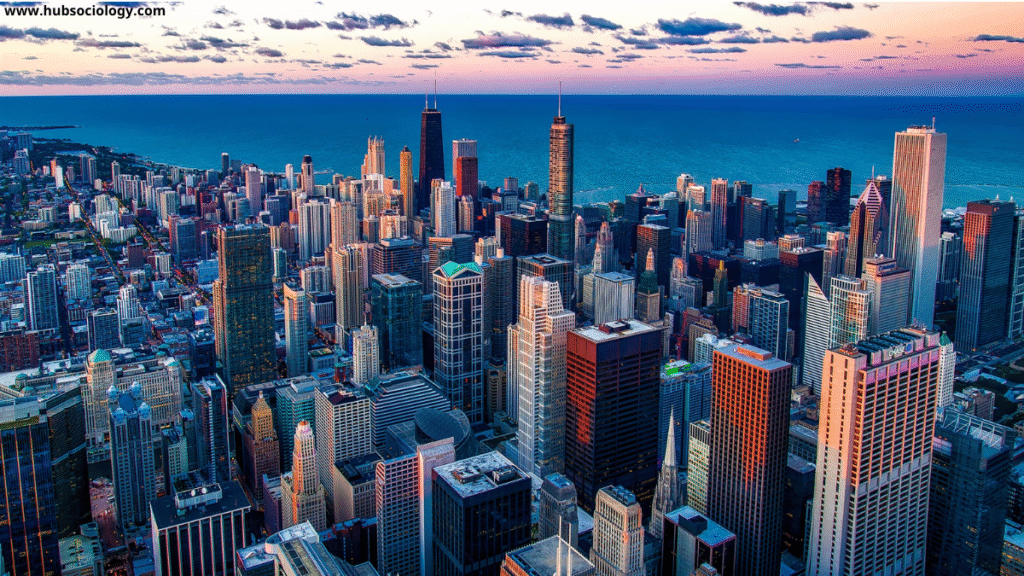Introduction
Globalization is often described as a modern phenomenon, closely linked with the spread of capitalism, digital technologies, multinational corporations, and transnational cultural flows. However, sociologist Ronald Robertson, one of the pioneering theorists of globalization, insists that globalization is not merely a recent development, but rather an age-old process with deep historical roots. His work challenges the notion that globalization began in the late twentieth century and instead emphasizes a long trajectory of interconnectedness that spans centuries, even millennia.
This article explores globalization as an age-old process through Robertson’s sociological lens, examining its historical stages, cultural implications, and significance for contemporary society.

Ronald Robertson and the Concept of Globalization
Ronald Robertson (1938–2018) was a Scottish sociologist who significantly shaped globalization theory. His influential book Globalization: Social Theory and Global Culture (1992) outlined globalization as a “compression of the world and the intensification of consciousness of the world as a whole.” For Robertson, globalization involves not only economic integration but also cultural, political, and social dimensions.
A key argument in his work is that globalization is not new but rather an age-old process of human history, marked by interaction, exchange, and interdependence among societies. By situating globalization historically, Robertson provides a sociological framework that challenges simplistic modernist interpretations.
Globalization as an Age-Old Process
Robertson identifies globalization as a multi-phase historical phenomenon. According to him, the process can be divided into five major phases, each marking a significant transformation in global interconnectedness.
1. The Germinal Phase (15th – 18th Century)
This phase coincides with the Renaissance, the Age of Exploration, and the beginnings of colonial expansion. During this period, global consciousness started to emerge. European voyages to Asia, Africa, and the Americas created sustained encounters between different civilizations. The discovery of the “New World” and the spread of Christianity began shaping a sense of global unity and division simultaneously.
From a sociological perspective, this phase marked the birth of a global imaginary, as societies began to see themselves in relation to the wider world.
2. The Incipient Phase (18th Century)
The Enlightenment and early industrialization further accelerated global interconnectedness. Ideas of universal human rights, democracy, and rationality spread beyond Europe, influencing revolutions in America and France. At the same time, global trade networks expanded through the colonial system, embedding non-European societies into an emerging global order.
Sociologically, this phase highlighted the interplay between cultural diffusion and political restructuring, laying the foundation for modern notions of nationhood and citizenship.
3. The Take-Off Phase (1870s – 1920s)
The late 19th and early 20th centuries witnessed a dramatic intensification of globalization. Industrial capitalism, the global gold standard, improved transportation (steamships, railways), and communication (telegraphs, newspapers) linked societies in unprecedented ways.
International organizations such as the Red Cross (1863) and the Olympic Games (1896) emerged, reflecting an increasing global consciousness. The idea of a shared world was becoming institutionalized.
Sociologically, this period showed the formation of transnational social structures, where collective activities and institutions transcended national boundaries.
4. The Struggle-for-Hegemony Phase (1920s – 1960s)
This phase corresponds with the world wars, decolonization, and the Cold War. It was marked by intense struggles over political and ideological dominance. At the same time, the foundation of the United Nations (1945), the Universal Declaration of Human Rights (1948), and international institutions like the World Bank and IMF signaled an attempt to institutionalize a global order.

This phase reflects Robertson’s emphasis on globalization as a dialectical process involving both conflict and cooperation. Globalization was not linear but contested, shaped by competing visions of world society.
5. The Uncertainty Phase (1960s – Present)
The contemporary period is characterized by rapid technological innovation, cultural exchange, global economic interdependence, and environmental challenges. However, globalization also produces uncertainty due to identity crises, nationalism, terrorism, and environmental threats.
In Robertson’s framework, the uncertainty phase highlights the ambivalence of globalization: it unites societies while simultaneously intensifying cultural clashes and political conflicts.
Globalization, Culture and Identity
Robertson’s key contribution is his emphasis on culture and identity in globalization. He introduced the concept of “glocalization,” referring to the simultaneous process of universalization and particularization. For example, global products like McDonald’s adapt to local cultures (serving McAloo Tikki burgers in India), showing that globalization does not erase local identities but reshapes them.
From a sociological standpoint, this demonstrates that globalization is not a homogenizing force alone; rather, it produces hybrid cultural forms where global and local interact.
Moreover, Robertson highlights the growing “consciousness of the world as a whole.” People increasingly see themselves as part of a global community while simultaneously struggling to preserve national, ethnic, and religious identities. This duality reflects the complex sociological dynamics of globalization as both integration and differentiation.
Globalization as a Historical Sociology
Robertson’s theory can be situated within historical sociology, as it traces the transformation of global interconnections across centuries. Unlike economic reductionist views (which see globalization primarily as capitalist expansion), Robertson stresses the cultural, political, and institutional dimensions of globalization.
For instance, the spread of world religions (Christianity, Islam, Buddhism), the development of calendars and time zones, and the rise of international law all represent globalizing forces predating modern capitalism. Thus, globalization is not merely economic but a civilizational process shaping collective consciousness over time.
Critiques and Debates
While Robertson’s view is influential, it is not without critique. Some sociologists argue that globalization should be understood as a late-20th-century phenomenon, driven by neoliberal policies, digital communication, and global finance. Critics suggest that earlier forms of interconnection were not truly “global” but rather regional or imperial.
However, Robertson responds by showing that globalization is cumulative, with earlier phases providing the structural and cultural groundwork for contemporary developments. His framework reminds us that globalization is multi-dimensional and historically deep, not reducible to economics or modern technology alone.
Sociological Implications
- Understanding Continuity and Change – Robertson’s framework helps sociologists see globalization as a historical continuum rather than a sudden rupture.
- Identity and Cultural Negotiation – Globalization produces hybrid identities through glocalization, highlighting the dialectic of the global and local.
- Global Institutions and Governance – The rise of international organizations, human rights frameworks, and transnational movements shows how globalization restructures social and political authority.
- Conflict and Integration – Globalization fosters cooperation but also intensifies conflicts, making it a deeply ambivalent process.
Conclusion
Ronald Robertson’s view of globalization as an age-old process broadens our sociological understanding of global interconnectedness. By tracing globalization through historical phases, he shows that the phenomenon is not confined to the late 20th or 21st century but rooted in centuries of exploration, cultural exchange, and institutional formation.

Globalization, in Robertson’s perspective, is both a historical and cultural process involving the compression of the world and the growing consciousness of globality. His concept of glocalization further highlights that globalization is not about uniformity but about the complex interaction of global and local dynamics.
For contemporary sociology, Robertson’s insights are invaluable. They remind us that globalization cannot be reduced to economics or technology; it is fundamentally about how societies imagine, negotiate, and live in a shared world.
Do you like this this Article ? You Can follow as on :-
Facebook – https://www.facebook.com/hubsociology
Whatsapp Channel – https://whatsapp.com/channel/0029Vb6D8vGKWEKpJpu5QP0O
Gmail – hubsociology@gmail.com
Topic-related exam-style questions
5 Marks Questions (Short Answer Type)
- Define globalization according to Ronald Robertson.
- What does Robertson mean by the “compression of the world”?
- Name the five phases of globalization outlined by Robertson.
- What is meant by “glocalization”? Give one example.
- Differentiate between globalization as an economic process and as a cultural process.
- Why does Robertson call globalization an “age-old process”?
- Mention one feature of the “take-off phase” of globalization.
- What role did the Renaissance play in the germinal phase of globalization?
- Write a short note on the uncertainty phase of globalization.
- How does globalization create both integration and conflict?
10 Marks Questions (Medium Answer Type)
- Discuss Robertson’s idea of globalization as an age-old process.
- Explain the sociological significance of the concept of “glocalization.”
- Outline the five historical phases of globalization as given by Ronald Robertson.
- How does globalization affect culture and identity according to Robertson?
- Critically examine Robertson’s contribution to globalization studies.
- Discuss the role of international institutions (e.g., UN, IMF, Red Cross) in the globalization process.
- How did the Enlightenment and early industrialization shape the incipient phase of globalization?
- Explain Robertson’s idea of globalization as the “intensification of consciousness of the world as a whole.”
- In what ways is globalization a dialectical process of both cooperation and conflict?
- Compare Robertson’s historical view of globalization with the view that globalization is a modern phenomenon.
15 Marks Questions (Long Answer Type)
- Examine Ronald Robertson’s historical phases of globalization and their sociological implications.
- Discuss in detail how globalization is an age-old process rather than a purely modern development.
- Evaluate the concept of “glocalization” in understanding the interaction between global and local cultures.
- Critically analyze Robertson’s perspective of globalization as both integration and differentiation.
- How does Robertson’s sociological theory of globalization differ from economic reductionist approaches?
- Assess the role of cultural and institutional factors in shaping globalization as explained by Robertson.
- Examine the uncertainty phase of globalization with reference to contemporary issues like nationalism, terrorism, and environmental crises.
- To what extent can Robertson’s view of globalization as a “civilizational process” be applied in the study of world religions and cultural exchanges?
- Discuss the strengths and limitations of Robertson’s theory of globalization in explaining present-day global interconnectedness.
- Analyze globalization as a historical-sociological process, highlighting Robertson’s contribution to the field.

1 thought on “Globalization: An Age-Old Process – Ronald Robertson’s Perspective”